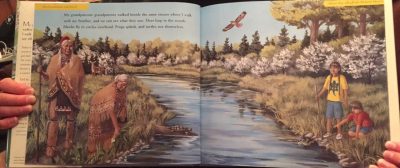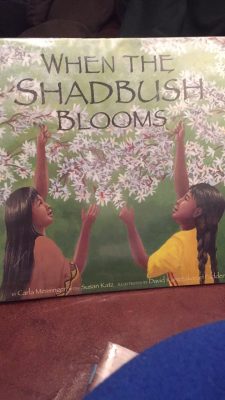- Title: Where the Shadbush Blooms
- Author(s): Carla Messinger
- Illustrator/Photographer: David Kanietakeron Fadden
- Publisher and Year: Tricycle Press, 2007
- Number of pages: 27
- Tags: Culture, Diversity, Family, K-5, Morgan Houk

- Genre: Realistic Fiction
- Analysis:
This story is about a little girl living in the present day who is a descendant from the Lenni Lenape tribe. She works on a farm with her family and extended family and they tell her many stories of what life was like for her ancestors. The story shows a mirror of the young girl’s present day activities accompanied by past flashbacks of what her ancestors would be doing at that particular time of year.
This book can act as a window into the life of a present day Native American living in the United States as well as into the lives of those that came before her many years ago. The reader is able to see the spirituality that the tribe has including how highly they hold the natural world around them. The reader is also able to see all of the physical labor and hard work that the Lenni Lenape tribe endured in order to ensure they would have crops to harvest come fall. This story can also act as a mirror for children that are Native American and living in today’s American society. In  some ways, this book could potentially act as a door for children to combat any racism towards Native Americans now that they have this better understanding of the culture and it really does not seem that different from the life of any other people.
some ways, this book could potentially act as a door for children to combat any racism towards Native Americans now that they have this better understanding of the culture and it really does not seem that different from the life of any other people.
I do not really see an issue of power in this book given that the only characters are present day Native Americans and those that lived in the past. Both groups appear to be on the same level in terms of power.
The illustrations look as though they are painted with acrylics. Most of the paintings are depicted outdoors, so the illustrator used a lot of bright colors for the sky, river, and forest that surrounds the characters. The characters are drawn with rather neutral colors such as brown and beige to show the deer skin clothing on the ancestors. The remaining characters are depicted in modern day, colorful clothing.
A wonderful feature about this book is that the back of the book includes more background on the Lenni Lenape tribe and goes more in depth into who these people really were. The author’s note reveals that the author is actually a descendent from the Lennie Lenape and her family has told her many stories about what life was like many years ago. Having this knowledge of the author as well as the more in-depth background of the Lenni Lenape, the reader can assume that the facts provided are accurate and that the story shows an accurate representation of their culture.
